Browse in the Library:
| Artist or Composer / Score name | Cover | List of Contents |
|---|---|---|
| ABRSM Piano Exam 2023-24 Grade 3 C3 THE ENTERTAINER – SCOTT JOPLIN |
 |
|
| ABRSM Piano Exam 2023-24 In The Groove by Mike Cornick |
 |
|
| ABRSM Piano Exam 2023-24 Indigo Moon by Elissa Milne |
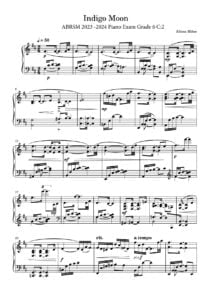 |
|
| ABRSM Piano Exam 2023-24 Jester’s Jig by Chee-Hwa Tan |
 |
|
| ABRSM Piano Exam 2023-24 Love Theme by Catherine Rollin |
 |
|
| ABRSM Piano Exam 2023-24 Minuet In G (Anonymous) |
 |
|
| ABRSM Piano Exam 2023-24 The Song Of Twilight by Yoshinao Nakada |
 |
|
| ABRSM Piano Exam Pieces Grade 1 2013 & 2014 syllabus |
 |
ABRSM Piano Exam Pieces Grade 1 2013 & 2014 syllabus |
| ABRSM Piano Exam Pieces Grade 1 2023 2024 |
 |
ABRSM Piano Exam Pieces Grade 1 2023 2024 |
| ABRSM Piano Exam Pieces Grade 1 2025 2026 |
 |
ABRSM Piano Exam Pieces Grade 1 2025 2026 |
| ABRSM Piano Exam Pieces Grade 2 2023 2024 |
 |
ABRSM Piano Exam Pieces Grade 2 2023 2024 |
| ABRSM Piano Exam Pieces Grade 3 2013 2014 |
 |
|
| ABRSM Piano Exam Pieces Grade 3 2023 2024 |
 |
ABRSM Piano Exam Pieces Grade 3 2023 2024 |
| ABRSM Piano Exam Pieces Grade 3 2025 2026 |
 |
ABRSM Piano Exam Pieces Grade 3 2025 2026 |
| ABRSM Piano Exam Pieces Grade 4 2021 2022 |
 |
ABRSM Piano Exam Pieces Grade 4 2021 2022 |
| ABRSM Piano Exam Pieces Grade 4 2023 2024 |
 |
|
| ABRSM Piano Exam Pieces Grade 5 2023 2024 |
 |
ABRSM Piano Exam Pieces Grade 5 2023 2024 |
| ABRSM Piano Exam Pieces Grade 6 2023 2024 |
 |
ABRSM Piano Exam Pieces Grade 6 2023 2024 |
| ABRSM Piano Exam Pieces Grade 7 2023 2024 |
 |
ABRSM Piano Exam Pieces Grade 7 2023 2024 |
| ABRSM Piano Exam Pieces Grade 8 2023 2024 |
 |
ABRSM Piano Exam Pieces Grade 8 2023 2024 |
| ABRSM Piano Exam Pieces Grade 8 2025 2026 |
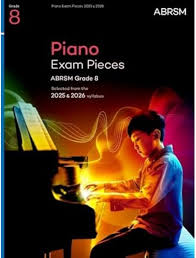 |
ABRSM Piano Exam Pieces Grade 8 2025 2026 |
| ABRSM Piano Mix 3 for Easy Piano Grades 3-4 |
 |
ABRSM Piano Mix 3 for Easy Piano Grades 3-4 |
| ABRSM Piano Prep Test |
 |
|
| ABRSM Piano Scales And Arpeggios from 2021 Guide For Practical Grades |
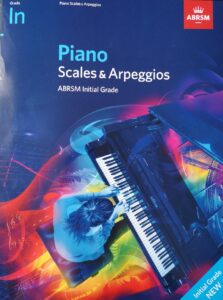 |
|
| ABRSM Selected Piano Exam 2011 2012 Grade 1 |
 |
|
| ABRSM Selected Piano Exam Grade 2 (2011 2012 ) |
 |
|
| ABRSM Specimen Aural Tests Grade 1 to 3 |
 |
|
| ABRSM Specimen Aural Tests Grade 4 & 5 |
 |
|
| ABRSM Teaching notes on piano exam pieces (2013 & 2014) |
 |
|
| ABRSM The Manual Of Scales Broken Chords And Arpeggios For Piano |
 |
|
| ABRSM Theory of Music Exams Grade 8 (The Associated Board of Royal Schools of Music) 2010 |
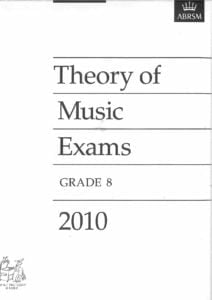 |
|
| AC/DC – Classic – Early Years – High Voltage And Let There Be Rock (Guitar Tab Songbook) |
 |
ACDC – Classic – Early Years – High Voltage And Let There Be Rock |
| AC/DC – Jam With AC/DC (PDF with MP3 audio tracks Guitar Tab Songbook) |
 |
Jam With ACDC |
| AC/DC Rock Score |
 |
|
| AC/DC, Best of (Guitar & Tablature) |
 |
Best Of ACDC (Guitar) |
| Ace Of Base – Beautiful Life | ||
| Ace Of Base – Dont Turn Around | ||
| Ace Of Base – Living In Danger | ||
| Acoustic 33 TOP Guitar Hits (Guitar Songbook) with Tablature – sheet music |
 |
Acoustic 33 TOP Guitar Hits (Guitar Songbook) – sheet music |
| Acoustic Blues Guitar By Kenny Sultan Guitar Tab |
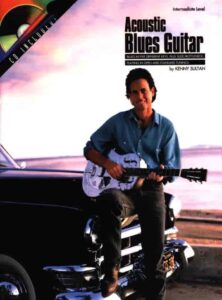 |
Acoustic Blues Guitar |
| Acoustic Blues Guitar Keith Wyatt with TABs |
 |
Acoustic Blues Guitar Keith Wyatt with TABs |
| Acoustic Blues Guitar Styles (Larry Sandberg) (with Tablature) |
 |
Acoustic Blues Guitar Styles (Larry Sandberg) |
| Acoustic Classics 42 songs Piano Vocal Guitar |
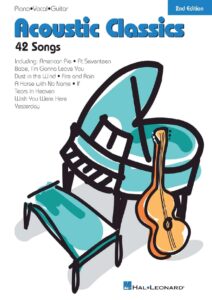 |
Acoustic Classics 42 songs Piano Vocal Guitar |
| Acoustic Guitar Bible (35 great songs) Guitar with TABs |
 |
Acoustic Guitar Bible (35 great songs) Guitar with TABs |
| Acoustic Rock (Guitar) Rolling Stones, Green Day, Pink Floyd, Bob Dylan (Songbook Guitar Tab) with Tablature |
 |
|
| Acoustic Rock 90’s, Best of – Guitar with Tablature |
 |
Acoustic Rock 90’s, Best of – Guitar |
| Acqua azzurra acqua chiara (Battisti) | ||
| Ad Te Levavi (Musescore File).mscz | ||
| Adagio (Lara Fabian) | ||
| Adagio MP3.zip | ||
| Adah’s Theme (La femme avec les yeux lumineux) Sex and the City |
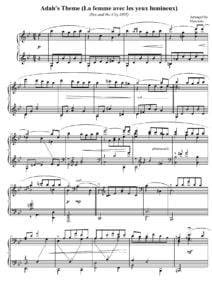 |
|
| Adah’s Theme (Le femme avec les yeux lumineux) Sex and the Cit | ||
| Adam – Adolphe Charles Holy Night Cantique-Nöel |
 |
|
| Adam – Cantique de Nöel Minuit Chretiens | Adam – Cantique de Noel Minuit Chretiens VS | |
| Adam – Derniers souvenirs d’un musicien |
 |
|
| Adam – O Holy Night | Adam – O Holy Night | |
| Adam – Souvenirs d’un musicien |
 |
|
| Adam (Cappeau) – Cantique de Noël. Easy Piano with voice or instrument (Paroles and lyrics) |
 |
Adam-Cappeau-Cantique-de-Noel- |
| Adam (Cappeau) – Cantique de Noel. Easy Piano with voice or instrument.mscz | ||
| Adam Cantique de Nöel Christmas song | Adam Cantique de noel | |
| Adam Carse – The History Of Orchestration Adam Carse |
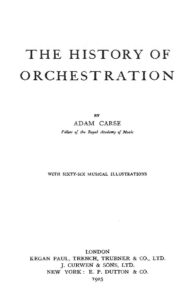 |
|
| Addams Family Theme (Musescore File).mscz | ||
| Addams Family Theme (Easy Piano) |
 |
|
| Addio Colonnello (Ennio Morricone) | ||
| Adele Songs from the Album 21 For SATB, SSA and Piano |
 |
Adele Songs from the Album 21 |
| Adele – 21 |
 |
ADELE 21 SONGBOOK |
| Adele – Chasing Pavements Piano Vocal guitar chords |
 |
|
| Adele – Easy on me (Piano solo with lyrics) |
 |
|
| Adele – Rolling in the Deep |
 |
|
| Adele – Rumor Has It |
 |
|
| Adele – Set Fire to the Rain |
 |
|
| Adele – Set Fire To The Rain (2) (Musescore File).mscz | ||
| Adele – Someone Like You | Adele – Someone Like You | |
| Adele – Someone Like You easy piano |
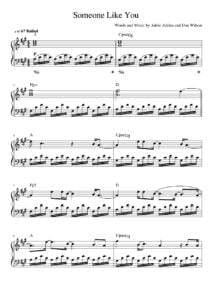 |
|
| Adele – The Best Of SongBook (12 songs arranged for easy piano) |
 |
Adele – The Best Of SongBook (12 songs arranged for easy piano) |
| Adele 19 [Piano, Guitar, Vocals] |
 |
Adele 19 [Piano, Guitar, Vocals] |
| Adele 25 Songbook |
 |
Adele 25 Songbook Contents —  |
| Adele Best Of Adele Big Note Piano (Adele Adkins) |
 |
Adele Best Of Adele Big Note Piano (Adele Adkins) |
| Adele Easy On Me Sheet Music |
 |
|
| Adele Original Keys For Singers (Adele) |
 |
Adele Original Keys For Singers (Adele) |
| Adele Skyfall (Piano Vocal Guitar Chords) | Adele Skyfall (Piano Vocal Guitar Chords) | |
| Adios Amor – Goodbye My Love as recorded by José Feliciano |
 |
|
| Adult All In One Course Level 1 With Audio Mp3 (Willard Palmer) |
 |
Lessons Alfred’s Basic Adult Piano Course Level 1 |
| Adult All In One Course Level 2 With Audio Mp3 (Willard Palmer) |
 |
Willard Palmer – Adult All-In-One Course Level 2 |
| Adult Greatest Movie Hits Piano Level 1 |
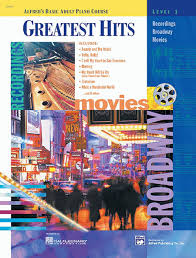 |
Adult Greatest Movie Hits Piano Level 1 |
| Adult Piano Adventures ALL-IN-ONE PIANO COURSE 1 |
 |
|
| Adult Piano Adventures All-In-One Piano Course Book 2 Book With Media Online (Nancy Faber, Randall Faber) Sheet Music |
 |
|
| Adult Piano Adventures Christmas – Book 1 (Nancy Faber Randall Faber) |
 |
|
| Adult Piano Adventures Christmas – Book 2 |
 |
Adult Piano Adventures Christmas – Book 2 |
| Adult Piano Adventures Popular Book 1 – Timeless Hits and Popular Favorites (Adult Piano Adventures Popular) |
 |
Adult Piano Adventures Popular Book 1 – Timeless Hits and Popular Favorites (Adult Piano Adventures Popular) |
| Adult Piano Course Greatest Movie Hits Piano Level 1 Recordings Broadway Movies |
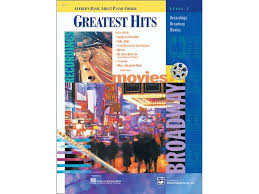 |
Adult Piano Course Greatest Movie Hits Piano Level 1 Recordings Broadway Movies |
| Advanced Harmonic Concepts by Wayne Naus (with audio MP3) |
 |
Advanced Harmonic Concepts by Wayne Naus |
| Advanced Harmonic Exercises For Jazz Piano |
 |
advanced harmonic exercises |
| Advanced Piano Solos 1 Encyclopedia by Tom Roed |
 |
Advanced Piano Solos 1 Encyclopedia by Tom Roed |
| Advanced Piano Solos 2 Complete by Tom Roed |
 |
Advanced Piano Solos 2 Complete by Tom Roed |
| Advanced Sacred Music Piano Solos by John Kraus |
 |
|
| Advanced Scale Concepts and Licks for Guitar (PDF + MP3 audio tracks Play Along) with Tablature |
 |
 |
| Aebersold – 110 – When I fall In Love – Romantic Ballads pdf with embedded audio MP3 Tracks |
 |
Jazz Play Along Vol 110 [When i Fall in Love] |
| Aebersold – 113 Embraceable You – Vocal Standards with audio MP3 Tracks |
 |
Jamey Aebersold – Vol 113 |
| Aebersold – 30 blues scale By Jamey Aebersold | Aebersold – 30 blues scale By Jamey Aebersold | |
| Aebersold – A New Approach To Jazz Improvisation Gettin’it together vol. 21 |
 |
aebersold gettin all together vol 21 |
| Aebersold – Practice Procedures For Memorizing Scales And Chords | Aebersold – Practice Procedures For Memorizing Scales And Chords | |
| Aebersold – Rapid Reference Vol 1-114 | Aebersold – Rapid Reference Vol 1-114 | |
| Aebersold – Vol 01 – How to Play and Improvise Jazz (with audio MP3) |
 |
Aebersold – Vol 01 – How to Play and Improvise Jazz |
| Aebersold – Vol 03 – The II-V7-I Progression Jazz Play Along Book + Audio Mp3 |
 |
|
| Aebersold – Vol 105 – Dave Brubeck Jazz Play Along Book + Audio Mp3 |
 |
|
| Aebersold – Vol 118 – [Groovin Jazz] (with audio MP3) |
 |
|
| Aebersold – Vol 32 – Ballads Jazz Play Along Book + Audio Mp3 |
 |
|
| Aebersold – Vol 34 – Jam Session Jazz Play Along Book + Audio Mp3 |
 |
Includes MP3 Play along themes as Blue moon, The shadow of your smile, Over the rainbow, etc. |
| Aebersold – Vol 45 – [Bill Evans] Jazz Play Along Book + Audio Mp3 |
 |
Aebersold – Vol 45 – [Bill Evans] |
| Aebersold – Vol 58 – Unforgettable Standards Jazz Play Along Book + Audio Mp3 |
 |
aebersold unforgettable standards sheet music |
| Aebersold – Vol 76 – David Baker – How To Learn Tunes (A Jazz Musician’s Survival Guide) |
 |
how to learn tunes |
| Aebersold 25 How To Practice By Jamey Aebersold | Aebersold 25 | |
| Aebersold Antonio Carlos Jobim Vol 98 – Bossa Nova Songbook Jazz Play Along Book + Audio Mp3 |
 |
Aebersold Antonio Carlos Jobim Vol 98 – Bossa Nova Songbook |
| Aebersold Anyone Can Improvise – 52 Points To Remember | Aebersold Anyone Can Improvise – 52 Points To Remember | |
| Aebersold Jazz EAR training (with audio MP3) |
 |
Aebersold Jazz EAR train |
| Aebersold Jazz Handbook 09 Tips For Learning A New Tune & Practice Procedures For Memorizing |
 |
Aebersold Jazz HANDBOOK |
| Aebersold Jazz Play-Along Books & audio MP3 1st Part Full Collection – Vol 1- 40 (with MP3) for all instruments |
Compressed file  Aebersold Full Collection Part 1 – Vol 1- 40 Aebersold Full Collection Part 1 – Vol 1- 40 |
40 volumes with MP3 Aebersold Book Index Vol.001-106 |
| Aebersold Jazz Play-Along Books & audio MP3 2nd Part Full collection Vol 41- 75 for all instruments | Compressed fileAebersold Full Collection Part 2 – Vol 41- 75.. | 35 volumes with MP3 Aebersold Book Index Vol.001-106 |
| Aebersold Jazz Play-Along Books & audio MP3 3rd Part Full Collection – Vol 76- 112 (with MP3) | Compressed fileAebersold Full Collection Part 3 – Vol 76- 112 | 37 volumes with MP3 Aebersold Book Index Vol.001-106 |
This monograph is an analysis of the first five pieces from an album by Chick Corea, Piano Improvisations, Volume One. The titles of the individual pieces are Noon Song, Song for Sally, Ballad for Anna, Song of the Wind, and Sometime Ago. These pieces, which form a suite of sorts, were chosen for a variety of reasons. High quality transcriptions are available, the pieces have never been dealt with in detail, and they embody an intriguing mixture of classical styles, jazz styles, improvisation, and composition.

Chick Corea: Life and Works
Armando Anthony “Chick” Corea was born June 12, 1941, in Chelsea, Massachusetts. He became interested in music at an early age, beginning piano study at the age of four.
His first training came through his father Armando, a jazz trumpeter and bandleader in the Boston area. At age seven, Corea began lessons with Salvatore Sullo, a concert pianist in the Boston area. With Sullo, Corea studied traditional piano technique and repertoire, including Bach, Beethoven, and Chopin. Corea was also exposed to jazz from early on. His influences include Bud Powell, Joe Henderson, McCoy Tyner, Herbie Hancock, and Bill Evans.
He was particularly interested in the music of Horace Silver, transcribing many of Silver’s tunes and solos.3 After graduating from high school, Corea attended the Juilliard School of Music for a short time before
leaving to pursue jazz as a full-time career. Some of Corea’s first significant professional engagements were with the Latin bands of Willie Bobo and
Mongo Santamaria, and Corea has retained a strong affinity for Latin music throughout his career. Other musicians with whom Corea worked early in his career (ca. 1964-67) include trumpeter Blue Mitchell and saxophonist Stan Getz.
Corea joined Miles Davis’s band in 1968, replacing Herbie Hancock as the keyboardist. This was a major event in Corea’s career, giving an international reputation. At that time Miles Davis and his band played a form of free jazz that involved group improvisation, polytonality, and use of electronic instruments.
After playing with Davis for three years, Corea left to pursue his own nonelectronic approach to free jazz, forming a band called Circle in the early seventies. According to Ian Carr, Circle “went even more deeply into
the European vein of abstraction. It created an acoustic music which often had no relation to Afro-American forms such as the blues or gospels, no coherent physical rhythmic grooves, but which featured much scurrying and chittering non-tonal improvisation.”
According to Corea, Circle was based on communication, both between players and with the audience. The group engaged in free improvisation with few limits and no pre-planning. Eventually the music seemed to be unrelated to anything, particularly the audience. Reflecting on his decision to leave, Corea said, “When I see an artist using his energies and technique to create a music way beyond the ability of people to connect with it, I see his abilities being wasted.” Corea’s departure from Circle coincided
with his discovery of Scientology and the writings of L. Ron Hubbard. Corea was particularly interested in
Hubbard’s ideas on communication. Regarding communication with the listener, Corea said, “My own particular code as a performer is this: it’s up to me to do something for an audience.”
In musical terms, Corea’s desire for greater communication with the audience led to a more accessible, lyrical style. A direct result of this was the recording of two volumes of Piano Improvisations in 1971.11 Shortly
thereafter, Corea formed a band called Return to Forever, which existed with various personnel throughout most of the seventies.
Return to Forever tended toward electric jazz rock or fusion, often combined with a Latin style. Corea also continued to play more traditional jazz on occasion. Return to Forever broke up in 1980. Since then, Corea has been involved in a wide variety of musical pursuits, including solo performances, duos, and ensembles. Musicians with whom he has collaborated include pianists Keith Jarrett, Herbie Hancock, and Friedrich Guida and vibraphonist Gary Burton. He has also recorded Mozart’s Concerto for Two Pianos and Orchestra and composed his own three movement piano concerto.
The most noticeable quality in Corea’s output is the wide variety of musical styles in which he has operated. It is noteworthy that this versatility has not come at the expense of quality. 1^ Ian Carr sums up the consensus of many writers: “Corea ranks with Herbie Hancock and Keith Jarrett as one of the leading keyboard virtuosi and composer-bandleaders since the late 1960s. He is one of the most original and gifted composers in jazz.” In
addition to the general admiration for Corea’s work, the Piano Improvisations in particular were given a glowing review in Down Beat magazine. The review begins discussing Corea’s ensemble playing and then moves to the Piano Improvisations’.
“Chick is an original and a giant. His playing is total; his harmonic thinking, melodies and rhythmic phrasing are so interwoven that everything he plays is complete.
That may be the reason why he has at long last recorded a solo album. Piano Improvisations Volume One, which happily implies that there
will be a volume two. His work there is truly beyond words. This is one of the most important piano albums I have heard.”
The review goes on to praise Corea’s use of a variety of styles.
The variety of styles in Corea’s output is not surprising, given the diversity of his training and influences. Corea describes his earliest musical training
with his father, where he learned “how to read and write music, which was all very important groundwork. He’d [i.e. Corea’s father] often write out arrangements of popular tunes that he played with his own band, but he’d
write them for my level, so I learned notation in a very meaningful way.”
In addition to jazz and Latin music, Corea was also influenced by a wide variety of classicalmusic. Asked about his repertoire for piano practice,
Corea replied, “Alban Berg’s Piano Sonata is one of myfavorite piano works. I’ll play anything by Bach, some ofChopin’s etudes, Mozart sonatas, or Messiaen’s pianomusic.”17 Corea’s more experimental music with Miles
Davis’s band and Circle reflects the influence of otherpractitioners of free jazz, such as Ornette Coleman, andalso the influence of avant-garde composers like KarlheinzStockhausen and John Cage.18 Corea’a use of quartalharmonies could be linked to sources as diverse as Alban
Berg,-McCoy Tyner,- Horace Silver, and Paul – H i n d e m i t h.
The eclectic nature of Corea’s style and output is reflected in his opinions on musical style. For Corea, barriers between styles are based not on genuine musical differences so much as they are on artificial social constructs. When asked whether certain fully notated music qualified as jazz, Corea replied, “You have one aspect of this backward, to my way of thinking. The user is the one who creates the style. I don’t ask myself,
‘does this work as jazz?’ I’ll create the music I need without thinking about style.” Corea is even more emphatic in a later interview:
“I’m trying to break down the barriers, actually, between jazz music and classical music. There’s such a rich tradition and a rich esthetic in both areas that I love to operate in. I see no barrier, myslef . …”
Certainly the Piano Improvisations are as much a manifestation of this philosophy as any of Corea’s works.
Piano Improvisations: General Comments
While the Piano Improvisations embody a wide varietyof styles, there are certain aspects that they all share. In the most basic sense, they all have the same texture: melody and accompaniment. Within that framework there is
considerable variety.
One of the most striking features of the Piano Improvisations is the degree to which they make use of both classical and jazz styles. Though the line between jazz and classical styles is sometimes indistinct, many elements in the Piano Improvisations can be traced to one tradition or the other. Jazz Influences, There are many characteristics of jazz that occur
frequently in the Piano Improvisations. The harmonies in jazz are extended or altered the majority of the time. It is very rare to have triads with no added tones. As a result, the extended tones are often omitted in the labeling. For example, a chord labeled as “II” can be assumed to contain a 7th and possibly a 9th without actually labeling the chord as “II7/9. ” The present study follows this convention, in that not every extended note is labeled. An attempt is made to provide as much detail as is necessary to understand the subject at hand.
The voicings reflect the importance of the extended chord tones. The 7 th, 9th, and 6th (or 13th) are prominent, while the 5th (unless it is altered) and even the root are often omitted. For example, the following would be a common jazz voicing of a C major chord:

This sonority could also be interpreted as a quartal harmony based on E. The context can clarify the role of a harmony; for example, the chord above might be preceded by a clear dominant harmony on G. There are cases in the Piano Improvisations in which there is no clear context,
leading to a certain amount of ambiguity.
The practice of omitting the root is probably derived from playing in ensembles with a string bass. The piano often leaves out the root to avoid clashing with the line created by the bass player. In solo playing, rootless
voicing may also be used for pragmatic reasons: it can be difficult to play a bass line, complex harmonies, and a melody simultaneously.
Rootless voicing of dominant 7th type harmonies leads to a peculiar ambiguity known in jazz as tritone substitution. Two of the main two notes of a dominant 7th chord, the 3rd and the 7th, are a tritone apart. Since
the tritone does not change when inverted, it is impossible to tell which is the 3rd and which is the 7th in a rootless voicing. This implies two possible roots, a tritone apart: a rootless dominant 7th chord on V could just as easily be interpreted as a dominant 7 th chord built on flat II. The example below shows two different possibilities for the same pitches and their resolutions.
The unplayed root is shown in parentheses:

Even the additional extensions of the chord can fit into either interpretation. For example, A-sharp (the raised 9th of the G7 chord) becomes B-flat (the added sixth of the D-flat7 chord). The actual root of the chord cannot be determined and is, in fact, immaterial, since the
resolution and voice-leading are identical in both cases.
In traditional jazz, as in classical music, there is a tendency toward root movement down a 5th or up a 4th. The most definitive chord progression in jazz is ii – V – I, very similar to IV – V – I in classical music. The rhythm in jazz tends to be more complex than is the norm in common practice classical music. Syncopation is used quite frequently. There is also a common occurrence known as “swing rhythm” or “swinging eighth
notes.” When this occurs, the rhythm as notated below:

would be performed in approximately the following manner:

This is somewhat similar to the use of “nqtes inégalés” in French baroque music. The Piano Improvisations make some use of swing rhythm, but not to a great extent.
Another convention of jazz, found somewhat more frequently in the Piano Improvisations, is Latin rhythm or bossa nova. Latin rhythm uses straight, rather than swung eighth notes. In this convention the left hand establishes a groove or beat, possibly involving syncopation but still with a perfectly steady pulse. The right hand plays off the relative steadiness of the left
hand, playing lines that are more syncopated. This often involves the superimposing of ternary figures on a duple meter, as demonstrated by Barry Kernfeld in the New Grove Dictionary of Jazz:

This blend of jazz and samba originated in Brazil and became popular in the USA in the 1960s.
Classical Influences
Classical conventions are also an important influence in the Piano Improvisations. One of the most obvious manifestations of this is the approach to form. The typical jazz tune form of two verses, a bridge, and a repeat of the verse (AABA) is noticeably absent in the Piano Improvisations. The structures used are similar to traditional classical forms. Corea often uses forms that are conducive to improvisation, such as rondo form or variations on a repeated harmonic progression.
Some of the more complex harmonies, including altered chords, highly extended chords, polychords, and quartal harmonies, have their origins in late 19th- or 20thcentury classical music. This is also true of the use of
a wide variety of scales and modes. Many of these traits began to be integrated into jazz before the Piano Improvisations. As a result, it is not always possible to determine whether these influences derive from 20thcentury classical music or from jazz that had already incorporated these elements. In Corea’s case there are indications, such as his familiarity with works of Berg and Messiaen, that he might have encountered this harmonic language in both idioms.
Individual Pieces: Noon Song
The tonic of Noon Song is D major, with some emphasis on P major as well. For the most part, the piece remains within the realm of traditional functional harmony. The form is driven by a series of variations on a repeated harmonic progression. This sectional form is cast in a
large two-part structure. The texture is reminiscent of a Chopin Nocturne, in that the left hand plays an arpeggiated accompaniment with lots of pedal, while the right hand plays a florid melody. There are motives that
appear throughout the piece, but there is little in the way of consistent “themes” or melodies.
Throughout most of the piece, there is no meter or sense of pulse, somewhat like the unmeasured preludes of the French clavecinists. There are what sound like downbeats, usually the low notes in the left hand, but in between, there is no consistent beat. The eighth notes are straight rather than in swing rhythm; the tempo is medium slow. There are some areas of the piece that depart from the general tendencies; these sections have more of a sense of meter, a faster tempo, and a different texture.
The title of Noon Song is appropriate: it is perhaps the brightest of the Piano Improvisations in mood and the only one in an unambiguous major key. Noon Song strikes the listener as an exuberant outpouring of spontaneous melody, but it is also based on a well defined formal
structure.
At the most basic level. Noon Song is a continuous set of free variations, each based on the same chord progression. There is no melodic theme on which the variations are based; formal articulations are created by changes of tempo, rhythm, texture, and local harmonic activity. The piece contains eight variations, and is divided into two large sections of four variations each. This creates a structure in which two different formal approaches or levels exist simultaneously. The use of a repeated chord progression provides continuity and unity, while the two-part structure of the piece is based on contrast and division.
Though these two trends contrast with each other, they are not mutually exclusive. The coexistence of these two formal approaches is central to the nature of the piece. Virtually every element of the music helps to create this mixture, or is subject to it. This is true of
the form, harmonies and tonal areas used, motivic
activity, rhythm, and texture.
The following chart shows how this is manifested in
the form and tonal areas used:

There are several formal elements that add to the unity of the piece. The most obvious of these is that every variation uses the standard chord progression and ends in the tonic key of D major. Furthermore, every
variation, regardless of how it begins, eventually returns to the music of the opening section.
Other formal elements show the two-part nature of the piece. Part one never leaves the tonic key. Indeed, the F major chord at m. 13 (which is not tonicized) is the only harmony in part I that is foreign to D major. Part two, on the other hand, contains many departures from the tonic. These range from the unprepared F# major harmony at the beginning of the variation 5 to tonicizations F major and its dominant in variations 6-8. Though each variation in part two ends in D major, they all begin away from the tonic.
As the piece progresses, the variations depart more radically from the original harmonic progression. These departures, along with the tonal and harmonic elements, are the main factors that establish a binary division of
the piece. Variation 1 presents the standard chord progression
in its original form:

This is a very traditional, tonal harmonic progression which can easily be expressed in terms of functional harmony: I V7/vi vi V7/V V7 I. Other than the movement from D to P-sharp 7, the motion is guided by the
circle of 5ths.
In addition to the chords themselves, the voicings generally remain the same throughout the piece as well. Note that even though the harmonies are tertian, the use of extended chords allows for quartal voicings. This is
the case in the upper three notes in all the chords except those in m. 4. The areas of D major harmony in this variation, and indeed throughout the piece, are often prolonged using a neighbor chord (also voiced in 4ths) which alternates with the D major chord. In variation 1 this occurs in mm. 1 and 6:

The sound of this chord has the effect of not quite being either on or off the tonic, similar to a dominant chord over a tonic pedal. Variation 2 also adheres closely to the standard chord progression, though the full progression is preceded by a partial statement at mm. 7-10. The most noteworthy change is the appearance of an F major chord at m. 13:

Though F is not tonicized here, its appearance forecasts significant areas of F major later in the piece. The way in which the chord is used— as a neighbor chord between two F-sharp 7 chords— also foreshadows the manner in which other excursions from the tonic will be treated.
Variation 3 (mm. 18-24) proceeds through the progression normally until m. 21, where the usual dominant harmony is replaced by an A major seventh chord. After a prolongation of A major 7, the progression backtracks to the F-sharp chord at m. 22 and then ends in the usual way.
In variation 4 several new chords are interposed into the standard progression (mm. 25-30):

G major (IV) appears at m. 26, between D major and F-sharp. When F-sharp arrives it is F-sharp minor, which is prolonged until m. 30 where it is converted to the standard F-sharp dominant sonority. The cadential area which is usually harmonized with V7 I, now contains the following progression (mm. 31-35):

Note that the E chord is now minor rather than major, hence no longer functioning as V/V. The following chord is not A (V), but G minor (borrowed iv). This is the chord preceding the tonic, resulting in a plagal cadence (with minor iv) rather than the standard authentic cadence. These changes, especially when combined with the crescendo in dynamics and the particularly long time spent on the tonic after its arrival, make for a more dramatic close for this section than for any so far. This is appropriate, as this variation brings part one to a close.
Variation 5 (nun. 36-43) is quite audibly different from that which comes before. One of the main reasons for this is the change in rhythm. Beginning at m. 36 the slow sensa misura feel gives way to a fast tempo with definite beats and a feeling of 5/4. The texture also changes, from florid melodies accompanied by arpeggiated chords with lots of pedal, to a jumpy staccato melody accompanied by staccato block chords. There is also a change in the treatment of the progression. Variation 5 goes through
the standard progression twice, beginning each time on V7/vi rather than I. The overall effect of this is that even though the standard progression is in use, B minor rather than D is emphasized.
The main harmonic variation in variation 5 occurs at the beginning of the section; the end of the section returns to the tonic. This is the paradigm for variations 5 through 8.
In variation 6, beginning at m. 46, the tonality shifts towards F major (flat III). There has been some preparation for the key of F through the F major chord at m. 13 as well the use of a G minor harmony (ii in F) at m. 34. The move to F is accomplished by using the D major harmony at the end of m. 45 as a dominant. This sets off a progression through the circle of fifths, leading to a strong cadence on F at m. 49. There is a slight detour at m. 47: a “premature” arrival on P. (mm. 45-49):

At m. 50 F major slides up to F-sharp 7 (V/vi), returning to the standard progression. This half-step motion is identical to that which occurred where F first appeared at m. 13-14. The chromatic neighbor concept has been expanded from a single chord to an entire section. From m. 50 the progression continues in the usual manner, ending on the tonic at m. 53.
Variation 7 also begins off the tonic, gravitating towards the dominant of F, C major. After beginning on a B-flat major 7th chord, the harmony descends a half step to A minor. At this point, a circle of fifths progression is initiated (reminiscent of the approach to F major in the variation 5), culminating in an ii V I cadence in C major at m. 57 (mm. 54-57).

At m. 58 C major slides down to B minor. This is similar to the manner in which the two F major sections were “resolved.” Though the movement is down rather than up, the chromatic neighbor concept definitely applies. When B minor (vi in D) is reached, the tonality returns to D major and the standard progression. The progression is completed from the point of return to B minor, and then repeated in its entirety. In the tonic cadences of both statements, A7 (V) has been replaced by G minor (iv).
This is identical to the plagal cadence used at the end of the fourth variation. It is also similar in that the dynamics are loud and there is a long denouement on the tonic. As in the previous case, this helps to provide a
more dramatic close to the section. Again this is appropriate, as this section ends the main body of the piece.
The Coda or variation 8 is similar to variation 6. The left hand accompaniment in the two sections is nearly identical, (m. 46; m. 68):

The rhythm and contour of the melody are also similar. In terms of harmony, both sections begin on a version of the ii chord in F (ii? at m. 68, V/V at m. 46) and go on to strong cadences in F major.
At m. 71 F major descends to E minor, ii in D major. Once again a section outside of D major “resolves” by half-step to a chord in the diatonic progression. This time the motion is down to ii (similar to mm. 57-58)
rather than the usual motion up to V/vi. The remainder of the section follows the standard progression.
While there is no secondary key area equal in significance to that of a sonata form, for example, F major fulfills a similar function in this piece. Rather than serving as the tonic of a large section, F major guides the tonality of several short sections of music. This creates a structure with several small departures from the tonic, rather than one main departure. These areas of tonal departure are also distinctive in other ways: motives used, texture, rhythm, etc.
One manifestation of the tension between D major and F major is the conflict between the pitches A# and B-flat. Though A# is not diatonic in the key of D, it is, of course, present in every P#7 chord (V7/vi). A-sharp is also present in almost every appearance of the V7/V chord, as an added sharp 4th (or 11th). B-flat, on the other hand, is crucial to the tonicization of F major, functioning as both the 7th in the dominant chord and the
3rd in the ii chord. In the case of the plagal cadences at the end of
variations 4 and 7, G minor serves as the borrowed subdominant in D major. The appearance of B-flat in the context of D major, particularly at such important points in the form, helps to form a link between P major and D major.
The treatment of form and harmony/tonality plays a major role in creating the mixture of contrast and unity in Noon Song, but motivic elements are equally important in this regard. The same motives are used throughout the piece, but they are used differently in parts one and two.
The main motive, designated x, is a descending stepwise figure in one of the following rhythms:

The interval spanned by the motive varies, though it is usually a fourth or a major third. There is often a stepwise ascent over the dominant leading up to the motive, which occurs over the tonic. The first occurrence of this
is at mm. 5-6:

This motive, or a version of it, appears at virtually every tonic arrival in the piece. While there are arrivals on the tonic within sections (mm. 11, 39, and 59), the most important cadences are at the ends of the sections (mm. 6, 18, 24, 35, 44, 53, 67, and 75). The treatment of the x motive at these points is another feature that supports the binary division of Noon Song.
The cadence at the end of variation 1, seen in the previous example, uses a version of the motive that A A A A descends through 8 7 6 5. This version of the motive, designated xl, is used at the cadential points in all of part one: variations 1-4. The motive is varied slightly in variation 2 where the motive begins one step higher than usual, (m. 18):

The cadences in part two use the x motive, but in new versions. The end of variation 5, for example, uses the following version of the motive, designated x2 (m. 43):

Variation 8 also uses this version of the motive in the cadence at m. 75. The x2 motive covers a major third (3 2 1) rather than a fourth (8 7 6 5). The descent to 1 gives x2 a more final quality than does the movement from 8 to A 5 in xl. This corresponds logically with the placement of xl in the beginning of the piece and x2 at the end.
The version of the motive used in the cadences of the variations 6 and 7 is a hybrid of xl and x2. It spans a A A major third like x2, but uses scale steps 7 6 5 rather than 3 2 l–similar to a truncated xl. This version,
designated x3, first appears at the end of the variation 6 section at m. 53.

It also appears at both tonic cadences of variation 7 at mm. 62 and 67.
The chart below provides an overall view of the motives used relative to the form.

In this format, it is easy to see the motivic contribution to the binary division of Noon Song. Various versions of the x motive also appear at
other, less important structural points, including tonic arrivals in the middle of sections (mm. 11, 39, and 62) and in various prolongations of final harmony (mm. 6, 44 and 45, and 67).
Other manifestations of the x motive play a lesser, though significant, role in the piece. One of these, designated x4, consists of two descending eighth notes, often a third or fourth apart: basically the skeleton of
the other x motives. Considered in isolation, it would be difficult to hear a relationship between x4 and the other X motives. The context in which x4 appears makes the relationship much more viable. Like the other occurrences of X, x4 is used at points of climax— generally strong
harmonic arrivals. The most striking example of this occurs at the first strong cadence on F major at mm. 48- 49.

This example, in which x4 is basically the skeleton of xl, also shows another contextual relation to xl. The stepwise ascent in the melody over a dominant harmony is the standard cadential formula throughout the piece. The ascent invariably leads to some form of the x motive. The other occurrences of x4 share these same attributes, though the harmonies involved are not necessarily a local dominant and tonic. The x4 motive also appears at mm. 13 and 15, and becomes the basis of an area of music from mm. 60 to 66.
The versions of the x motive are the most important motivic material of the piece. There is, however, another motive that plays a substantial role. This motive, designated y, consists of three notes: a beginning note descends to a repeated tone. The rhythm is generally even, often with the feel of a triplet. The lower notes are usually chord tones, while the first note is an upper neighbor. The y motive is first seen at the last note of
the right hand of m. 1, and the first two notes of m. 2. It is seen below in a more basic form (without the intervening barline and in a lower register):

The y motive appears in several forms and contexts. It often occurs as part of the ornate melody in the right hand. It is also the origin of the theme at m. 7.

A small section of music in measure 21 is also based on y , this time in retrograde form.

At m. 5 the motive is heard in an inverted form which is then extended upwards. This generates a stepwise ascent which is part of the cadential formula used throughout the piece, (m. 5):

The melody at the beginning of variation 6 is a variant of the y motive in augmentation, (mm. 45-46):

The next section uses the y motive in a decorated version. This occurs at the cadence in C major and again at the return to the vi chord in the diatonic progression in D major (mm. 57-58).

The contour and rhythm provided by the added note create a hybrid of the x and y motives.
The discussion of the x and y motives has centered on their appearance at important points in the structure. They are also part of the melody in many other places of lesser importance, which are too numerous to mention.
The X and y motives are used throughout the piece. There is another theme that is important only in variation 5.It first appears at m. 36.

Though the contour and intervallic content vary, the rhythm and articulation are constant. This theme is repeated several times forming a consistent phrase structure from m. 36 to m. 40. This regularity, a quality
lacking in variations 1-4, is a significant factor in creating contrast between parts one and two.
Rhythmic characteristics also play a role in distinguishing the two sections of the piece. The first section is in a moderately slow tempo, almost entirely without a regular pulse. There are what seem to be downbeats–the low notes of the left hand–but between them there is no consistent pulse. The second section contains a substantial amount of music that does have a regular beat. This contrast is especially evident at the beginning of the B section, which has a strong metric feel of 5/4, as well as a fast tempo.
Other areas with a regular beat are mm. 36-42, mm. 46-48, mm. 54-58, mm. 60- 66, and mm. 68-69.
Along with the contrast in rhythm, there is a corresponding difference in texture. In the non-metric sections of the first part, the left hand generally plays some sort of arpeggiated figure while the right hand plays a highly ornate melody. In the more metric sections of the second part, the left hand plays more bass notes followed by block chords in a regular metric pattern.
There are qualities of Noon Song, particularly the use of the theme-and-variation genre, that are typical of improvised music. However, in many ways Noon Song is extraordinary. The gradual introduction of a secondary
key area is unusual, as are the subtle ways in which the contrast between the two key areas is played out. The economy of motivic materials provides coherence, while the variation of motives adds contrast and definition. The
unusual aspects of Noon Song are not ends in themselves, but contribute to the creation of the two-part form. All these musical elements, common and uncommon, interact to form a balanced, multilevel, formal structure. This skillful layering of different formal approaches permeates the music and is the most fascinating quality of Noon Song.
Chick Corea, “Noon song“, album Piano improvisations vol. 1, 1971
Best site for site music download.
Browse in the Library:
| Artist or Composer / Score name | Cover | List of Contents |
|---|---|---|
| (500) Days Of Summer Piano Theme ( Mychael Danna, Rob Simonsen) | (500) Days Of Summer Piano Theme ( Mychael Danna, Rob Simonsen) | |
| 10,000 Maniacs Because The Night Piano Solo sheet music |
 |
|
| 100 Golden Standards The World’s Best Piano Arrangements by the greatest pianists of the Century |
 |
The World’s Best Piano Arrangements |
| 100 Great Keyboard Intros Songbook |
 |
100 Great Keyboard Intros Songbook |
| 100 Greatest Film Scores (Book) by Matt Lawson & Laurence E. MacDonald |
 |
|
| 100 greatest POP songs |
 |
100 greats pop songs |
| 100 Greatest Songs of Rock & Roll, Selections From Piano Vocal Guitar Sheet Music |
 |
100 Greatest Songs of Rock & Roll, Selections From Piano Vocal Guitar Sheet Music |
| 100 Hits Simply The Best – Guitar (Die besten Songs aus Pop Rock) German |
 |
100 Hits Simply The Best (Die besten Songs aus Pop |
| 100 Jazz & Blues Greats Book |
 |
100 Jazz & Blues Greats |
| 100 Jazz Solos & Etudes by Jacob Wise |
 |
100 Jazz solos |
| 100 Light Classics For Piano Solo |
 |
100 Light Classics For Piano Solo |
| 100 Most Beautiful Christmas Songs Easy Piano Vocal |
 |
100 Most Beautiful Christmas Songs Easy Piano Vocal |
| 100 Most Beautiful Christmas Songs Piano Vocal Guitar |
 |
100 Most Beautiful Christmas Songs Piano Vocal Guitar |
| 100 Must-Know Jazz Tunes with MP3 audio tracks to Play Along |
 |
100 Must-Know Jazz Tune – C version |
| 100 of the Best Movie Songs Ever! Piano Vocal Guitar |
 |
100 best movie songs 1&100 best movie songs 2 |
| 100 Of The Best Songs Ever For The Keyboard by Daniel Scott |
 |
100 Of The Best Songs Ever For The Keyboard |
| 100 Piano Solos (100 popular standards of today arr. by Frank Booth) with guitar chords |
 |
100 piano solos 1 |
| 100 Pop Hits Of The 90’s by Dan Coates |
 |
100 Pop Hits Of The 90’s by Dan Coates |
| 100 Rock N Roll Standards Piano Vocal Guitar chords |
 |
100 Rock N Roll Standards Piano Vocal Guitar chords contents |
| 100 Songs For Kids – Easy Guitar Lyrics with Tablature |
 |
100 Songs For Kids – Easy Guitar Lyrics |
| 100 Tunes Every Musician Should Know Professional Chord Changes And Substitutions By Dick Hyman |
 |
100 Tunes Every Musician Should Know Professional Chord Changes And Substitutions By Dick Hyman |
| 100 Ultimate Blues Riffs For Piano Keyboards |
 |
100 ultimate riffs jazz piano |
| 100 Women Of Pop And Rock 100 songs by 100 artists |
 |
100 Women Of Pop And Rock 100 songs by 100 artists Piano Vocal Guitaral Leonard |
| 100 Years Of Popular Music 1980s Part Two Piano Vocal Guitar Chords |
 |
100 Years Of Popular Music 1980s Part Two Piano Vocal Guitar Chords |
| 1000 Examples of Musical Dictation (Ladukhin, Nikolay) | 1000 Examples of Musical Dictation | |
| 1000 Words – Final Fantasy X-2.mscz | ||
| 1001 Blues Licks by Toby Wine – Piano |
 |
1001 Blues Licks by Toby Wine – Piano |
| 1001 Jazz Licks A Complete Jazz Vocabulary For The Improvising Musician (Jack Shneidman) |
 |
1001 Jazz Licks A Complete Jazz Vocabulary For The Improvising Musician (Jack Shneidman) |
| 101 Cançoes Que Tocaram O Brasil Nelson Motta (Book) (Brazilian Portuguese) |
 |
|
| 101 Frank Sinatra Hits For Buskers |
 |
101 Frank Sinatra Hits For Buskers |
| 101 Mississippi Delta Blues Fingerpicking Licks Guitar and TAB by Larry McCabe |
 |
Larry McCabe – 101 Mississippi Delta Blues Fingerpicking Licks |
| 101 Must-Know Blues Licks (Guitar Educational) (Wolf Marshall) PDF + MP3 audio tracks Play Along with Tablature |
 |
101 Must-Know Blues Licks (Guitar Educational) (Wolf Marshall) |
| 1015 Songs – The Original Musicians’s (Musicals) |
 |
1015 Songs – The Original, Musicians’s (Musicals) |
| 106 Songs Everybody Plays |
 |
106 Songs Everybody Plays |
| 11 Short Classical Piano Pieces |
 |
11 Short Classical Piano Pieces |
| 116 Arrangements Of Baroque, Classical & Ballet Pieces For Piano Solo |
 |
116 Arrangements Of Baroque, Classical & Ballet Pieces For Piano Solo |
| 129 Easy Pieces For Piano Solo, also for beginners |
 |
129 easy pieces for piano solo |
| 12th Street RAG – Liberace Collection Book of 5 compositions |
 |
 |
| 12th Street Rag by Euday Bowman (Piano Solo sheet music, Noten, partition, partitura, spartito).mscz | ||
| 150 Best Songs For Acoustic Guitar |
 |
|
| 150 More Of The Most Beautiful Songs Ever (Songbook) Piano Vocal Guitar |
 |
150 More Of The Most Beautiful Songs Ever (Songbook) Piano Vocal Guitar |
| 150 Of The Best Jazz Standards Ever |
 |
150 Of The Best Jazz Standards Ever |
| 150 Of The Most Beautiful Songs Ever 3rd Edition |
 |
150 Of The Most Beautiful Songs Ever 3rd Edit1 and 150 Of The Most Beautiful Songs Ever 3rd Edit2 |
| 16 Pop and Movies Hits Keyboard Piano Book (Mike Emerson) |
 |
16 Pop and Movies Hits Keyboard Piano Book (Mike Emerson) |
| 1600 Pennsylvania Avenue The Musical By Leonard Bernstein And Alan Jay Lerner Vocal Selections |
 |
|
| 17 Moments of Spring – Mgnovenia (Mikael Tariverdiev) | ||
| 1812 Overture Op. 49 Thaikovsky (arr. piano solo) |
 |
|
| 1950s Jazz (Fake Book lead sheet music) |
 |
1950s Jazz (Fake Book lead sheet music) |
| 20 Century Fox Theme Transcription By Deusde Coppen |
 |
|
| 20 Modern BEBOP Licks – by Noah Kellman All Keys with left hands chords |
 |
20 Modern BEBOP Licks – by Noah Kellman All Keys with left hands chords |
| 200 Jazz Standards Tunes (chords progressions for C Instruments) Bob Taylor |
 |
200 Jazz Standards Tunes (chords progressions for C Instruments) Bob Taylor |
| 200 Of The Best Songs From Jazz Of The ’50s | jazz of the 50s | |
| 2014 Top Hits Of 2014 Songbook Piano Vocal Guitar |
 |
2014 Top Hits Of 2014 Songbook Piano Vocal Guitar |
| 2016 Top Hits Of 2016 Songbook Piano Vocal Guitar |
 |
2016 Top Hits Of 2016 Songbook Piano Vocal Guitar |
| 2018 Greatest Pop Movie Hits Songbook For Piano |
 |
2018 Greatest Pop Movie Hits Songbook For Piano |
| 2019 GREATEST POP MOVIE HITS SONGBOOK FOR PIANO PART 2 Piano sheet music (Jim Presley) |
 |
2019 GREATEST POP MOVIE HITS SONGBOOK FOR PIANO PART 2 Piano sheet music (Jim Presley) |
| 2020 Greatest Pop Piano Sheet Music Book Songbooks For Piano |
 |
2020 Greatest Pop Piano Sheet Music Book Songbooks For Piano |
| 20th Century Classics Volume 1 |
 |
20th Century Classics Volume 1 |
| 20th Century Jazz Guitar by Richie Zellon (with Tablature) |
 |
20th Century Jazz Guitar by Richie Zellon |
| 20th Century Masters Of Fingerstyle Guitar by John Stropes |
 |
20th Century Masters Of Fingerstyle Guitar by John Stropes |
| 20th Century Piano Music – Book (1990) David Burge |
 |
20th Century Piano Music Book (1990) David Burge |
| 24 Etudes Op.35 – Fernando Sor (1778 – 1839) (Musescore File).mscz | ||
| 24_Preludes_Op.34 Shostakovich.mscz | ||
| 25 Short Classical Guitar Pieces (with Tablature) |
 |
25 Short Classical Guitar Pieces |
| 262 Classic Piano Rags Various Composers |
 |
262 Classic Piano Rags Various Composers |
| 273 Easy And Intermediate Piano Pieces |
 |
273 Easy And Intermediate Piano Pieces contents |
| 28 Modern Jazz Trumpet Solos Book 2 |
 |
28 Modern Jazz Trumpet Solos Book 2 |
| 3.10 to Yuma (Marco Beltrami) | ||
| 30 Best Rock Guitar Songs Ever (Guitar TABs) |
 |
30 Best Rock Guitar Songs Ever (Guitar TABs) |
| 300 Sacred Songs Melody Lyrics Chords Fake Book Melody Lyrics Chords |
 |
300 Sacred Songs Melody Lyrics Chords Fake Book Melody Lyrics Chords_compressed |
| 36 Christmas Carols Songs |
 |
36 christmas carols songs |
| 38 Special Guitar Anthology Guitar Recorded Vers. with Tablature |
 |
38 special guitar anthology |
| 39 Progressive Solos For Classical Guitar (with Tablature) |
 |
39 Progressive Solos For Classical Guitar |
| 39 Progressive Solos For Classical Guitar Book 2 (with Tablature) |
 |
39 Progressive Solos For Classical Guitar Book 2 sheet music pdf |
| 40 Easy Guitar Pieces (Painted with the Sound) |
 |
|
| 49 Most Popular Jazz Songs |
 |
49 Most Popular Jazz Songs |
| 5 Christmas Songs Sheet Music Trumpet in B & Piano accompaniment (Viktor Dick) | 5 Christmas Songs Sheet Music Trumpet in B & Piano accompaniement (Viktor Dick) | |
| 50 Broadway Shows 50 Broadway Songs |
 |
50 Broadway Shows 50 Broadway Songs |
| 50 Classical Guitar Solos In Tablature (Howard Wallach) with Tablature |
 |
50 Classical Guitar Solos In Tablature (Howard Wallach) |
| 50 Essential Bebop Heads Arranged For Guitar Tablature (best lines Charlie Parker, Dizzy Gillespie, Thelonious Monk and more) |
 |
50 Essential Bebop Heads Arranged For Guitar Tablature (best lines Charlie Parker, Dizzy Gillespie, Thelonious Monk and more) |
| 50 Jazz Standards Every Jazz Musician Needs To Know with MP3 audio tracks to Play Along |
 |
50 Jazz Standards Every Jazz Musician Needs To Know – C version |
| 50 Most Popular Classical Melodies (Easy Piano) |
 |
50 Most Popular Classical Melodies |
| 50 Of The Most Beautiful Piano Love Songs Solos Ever. |
 |
50 OF THE MOST BEAUTIFUL PIANO LOVE SONGS SOLOS EVER |
| 50 Piano Arrangements Of Hymns And Gospel Songs (Fred Bock’s Best) |
 |
50 Piano Arrangements Of Hymns sheet music |
| 50 Piano Classics – Easy |
 |
50 piano classics |
| 50 Riffs For Blues Guitar – Martin Shellard with MP3 audio to Play Along with Tablature |
 |
50 riffs for blues guitar |
| 500 Piano Intros For The Great Standards – Steinway |
 |
500 piano intros |
| 55 Country Classics (Voice, piano, Guitar) |
 |
55 Country Classics (Voice, piano, Guitar) |
| 557 Jazz Standards (Sheet Music – in C for all instruments) swing to bop (lead sheet) |
 |
Standards (Sheet Music – Piano) |
| 60 Progressive Solos For Classical Guitar By Mark Phillips (with Tablature) |
 |
|
| 67 Fun Songs arranged by Jon Schmidt (Piano) |
 |
|
| 70’s Hits (Easy Piano Solos) – Hans-Gunter Heumann [Piano, Vocal, Chords] |
 |
 |
| 750.000 anni fa.l’Amore (Banco del Mutuo Soccorso) | ||
| 75th Anniversary A Tribute In Music From The 20s Through The 90s Various Artists Warner Bros |
 |
75th Anniversary A Tribute In Music From The 20s Through The 90s Various Artists Warner Bros |
| 78 Quarterly No 1 and 2 (1967) Book magazine |
 |
|
| 8 ½ Theme (Nino Rota) | ||
| 8 Femmes (Krishna Levy) | ||
| 8 Jazz scales you need to know.mscz | ||
| 80 Most Requested LDS Songs (Mormon music) |
 |
80 Most Requested LDS Songs (Mormon music) |
| 88 Piano Classics For Beginners – David Dutkanicz |
 |
88 Piano Classics For Beginners – David Dutkanicz |
| 88 The Giants Of Jazz Piano by Robert L. Foerschuk (Book) foreword by Keith Jarrett |
 |
|
| 9 easy guitar pieces – Sveinn Eythorsson |
 |
|
| 97 Oeuvres pour Guitare de Jean Francois DELCAMP |
 |
97 Oeuvres pour Guitare de Jean Francois DELCAMP |
| 99 Easy Piano Pieces |
 |
99 Easy Piano Pieces |
| A Beautiful Mind – A Kalidoscope of Mathematics |
 |
|
| A Beautiful Mind – All Love Can Be | A Beautiful Mind – All Love Can Be | |
| A Beautiful Mind – Kalidoscope | ||
| A Child Is Born – Oscar Peterson (Musescore File).mscz | ||
| A Chordal Concept For Jazz Guitar by Peter O’Mara |
 |
A Chordal Concept For Jazz Guitar by Peter O’Mara |
| A Ciascuno il Suo (Luis Bacalov) | ||
| A Clare Benediction – John Rutter – Piano Solo Arr. (Musescore File).mscz | ||
| A Clockwork Orange (Beethoviana) | A Clockwork Orange (Beethoviana) | |
| A Clockwork Orange (Beethoviana) (Musescore File).mscz | ||
| A Comparative Study Of The 24 Preludes Of A. Scriabin And Sergei Rachmaninoff (book) |
 |
|
| A Complete Course of Instruction For The Piano-Forte (Dr Karl Merz) (1885) |
 |
Instruction… |
| A Cool Yule. Ten Jazzy Christmas Songs |
 |
A Cool Yule. Ten Jazzy Christmas Songs |
| A Creative Approach To Jazz Piano Harmony Bill Dobbins |
 |
A Creative Approach To Jazz Piano Harmony Bill Dobbins |
| A Creative Approach To Practicing JAZZ – by David Baker |
 |
A Creative Approach To pravtising Jazz |
| A Dance of Dragons – Blood of the Dragon (Game of Thrones) Piano solo arr. |
 |
|
| A Dictionary of Music and Musicians Vol. 4 (A.D. 1450-1880) Edited in 1889 |
 |
